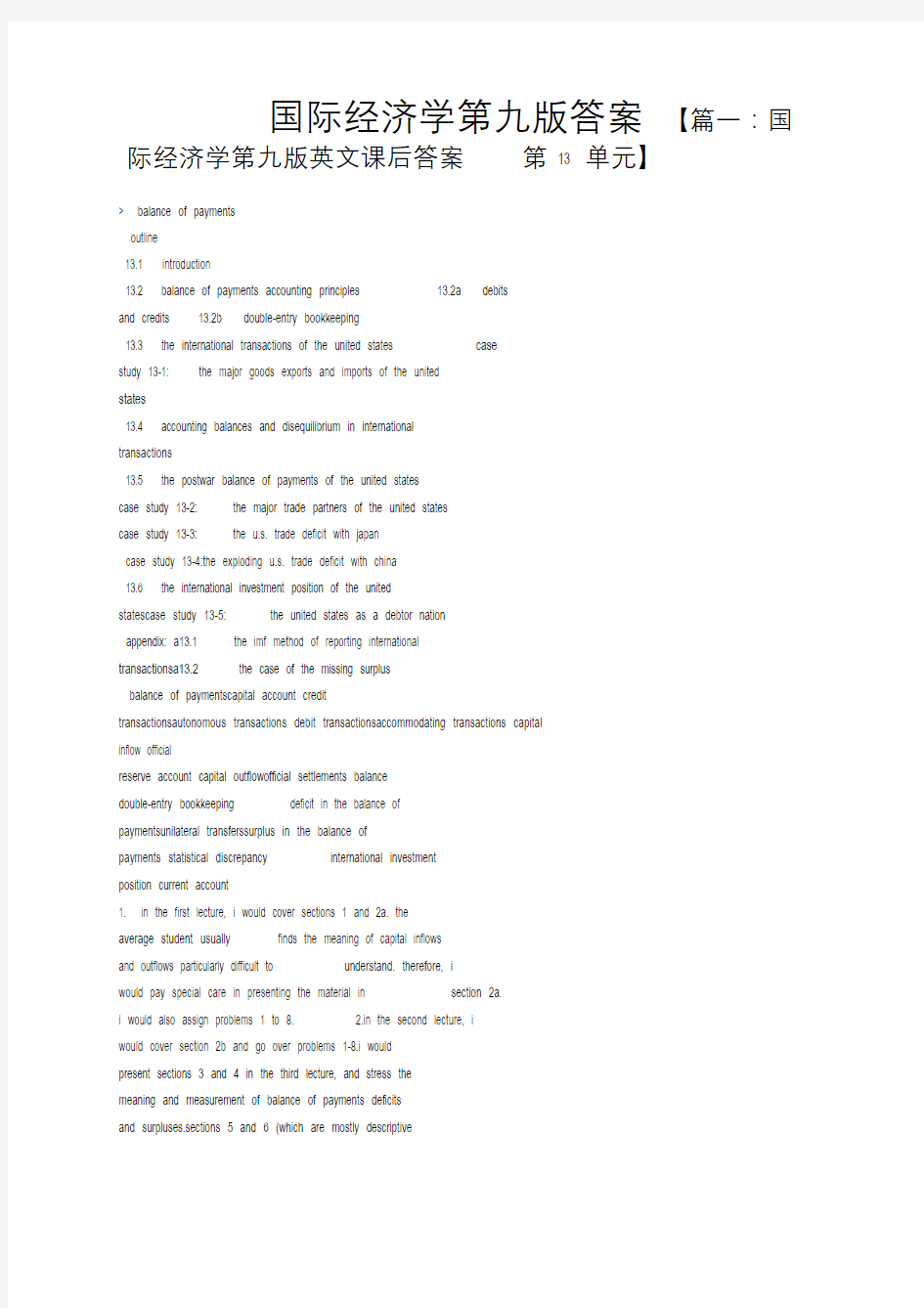
国际经济学第九版答案.doc
- 格式:doc
- 大小:69.50 KB
- 文档页数:12


国际经济学第九版答案【篇一:国际经济学第九版英文课后答案第13 单元】
> balance of payments
outline
13.1 introduction
13.2 balance of payments accounting principles 13.2a debits
and credits 13.2b double-entry bookkeeping
13.3 the international transactions of the united states case
study 13-1: the major goods exports and imports of the united
states
13.4 accounting balances and disequilibrium in international
transactions
13.5 the postwar balance of payments of the united states
case study 13-2: the major trade partners of the united states
case study 13-3: the u.s. trade deficit with japan
case study 13-4:the exploding u.s. trade deficit with china
13.6 the international investment position of the united
statescase study 13-5: the united states as a debtor nation
appendix: a13.1 the imf method of reporting international
transactionsa13.2 the case of the missing surplus
balance of paymentscapital account credit
transactionsautonomous transactions debit transactionsaccommodating transactions capital
inflow official
reserve account capital outflowofficial settlements balance
double-entry bookkeeping deficit in the balance of
paymentsunilateral transferssurplus in the balance of
payments statistical discrepancy international investment
position current account
1. in the first lecture, i would cover sections 1 and 2a. the
average student usually finds the meaning of capital inflows
and outflows particularly difficult to understand. therefore, i
would pay special care in presenting the material in section 2a.
i would also assign problems 1 to 8. 2.in the second lecture, i
would cover section 2b and go over problems 1-8.i would
present sections 3 and 4 in the third lecture, and stress the
meaning and measurement of balance of payments deficits
and surpluses.sections 5 and 6 (which are mostly descriptive
and not difficult) could be left for studentsto do on their own so that the chapter could still be covered in three lectures. 1. a.the u.s. debits its current account by $500 (for the merchandise imports) and credits capital by the same amount (for the increase in foreign assets in the u.s.).the u.s. credits capital by $500 (the drawing down of its bank balances in london, a capital inflow) and debits capital by an equal amount (to balance the capital credit that the u.s. importer received when the u.k. exporter accepted to be paid in three months).the u.s. is left with a $500 debit in its current account and a net credit balance of $500 in its capital account.
2. a).the u.s. debits unilateral transfers by $100 and credits capital by the same amount.
b).the u.s. credits its current account by $100 and debits capital by the same amount.
c).the debit of $100 in unilateral transfers and the credit of $100 in current account.
3. a).the same as 2a.the net result is the same, but the transaction in part a of this problem refers to tied aid while transactions a and b in problem 2 do not.
4. the u.s. debits capital account by $1,000 (for the purchase of the foreign stock by the u.s. resident) and also credits the capital account (for the drawing down of the u.s. resident bank balances abroad) by the same amount.
5. the u.s. credits its current account by $100 and debits its capital account by the same amount.
6. the u.s. credits its capital account by $400 (for the purchase of the u.s. treasury bills by the foreign resident) and debits its capital account (for the drawing down of the foreign residents bank balances in the united states) for the by the same amount.
7. the u.s. debits its current account by $40 for the interest paid, debits its capital account by $400 (for the capital outflow for the repayment of the repayment of the principal to the foreign investors by the u.s. borrower), and then credits its capital account by $440 (the increase in foreign holdings of u.s. assets, a credit).
8. a). the u.s. credits its capital account by $800 and debits its official reserves account by the same amount.
b). the official settlements balance of the u.s. will improve (i.e., the u.s. deficit will fall or its surplus will rise) by $800.